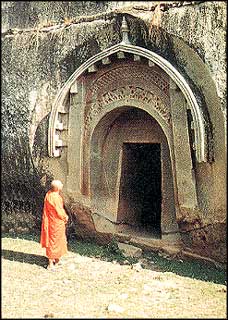|
 Although
the Buddha was the greatest teacher of his time he was certainly
not the only one. There was Nigantha Nataputta the founder
of Jainism, Purana Kassapa, Ajita Kesakambali, Pakudha Kaccayana
and Makkhali Gosala. This last teacher founded a school
called the Ajivakas which lasted for some centuries and
then petered out. For a review of the doctrines of these
and other teachers contemporary with the Buddha see the
Samannaphala Sutta in Walshe's Long Discourses. Although
the Buddha was the greatest teacher of his time he was certainly
not the only one. There was Nigantha Nataputta the founder
of Jainism, Purana Kassapa, Ajita Kesakambali, Pakudha Kaccayana
and Makkhali Gosala. This last teacher founded a school
called the Ajivakas which lasted for some centuries and
then petered out. For a review of the doctrines of these
and other teachers contemporary with the Buddha see the
Samannaphala Sutta in Walshe's Long Discourses.
Being
a sincere Buddhist the emperor Asoka was tolerant of the
other religions in his vast realm . Proof of this are the
remarkable caves he had cut on the stark and rocky Barabar
Hills for the use of Ajivaka ascetics. The most interesting
of these is the one called Lomas Rishi Cave. Carved out
of a huge rounded granite hummock the facade of this cave
is an exact replica of the wood and thatch kutis that ancient
ascetics including Buddhist monks used to live in. The interior
of the cave is consists of a large rectangular chamber with
a remarkable glass-like polish. The whole thing looks like
it has been cut out of the rock by a giant laser.
E.M.
Foster used this cave as the setting for the dramatic incident
in his  famous
novel A Passage To India. The two other caves on the hill,
Sudama and Chaupar and the one on nearby Nagarjuni Hill
cut by Asoka's grandson, have polished interiors but plain
exteriors. The Barabar Hills are about 20 kilometres north
of Gaya just off the Gaya-Patna road. When you are finished
at Bodh Gaya the next leg of your pilgrimage is to Rajgir
some 80 kilometres north-east of Gaya with a stop on the
way at Kurkihar. famous
novel A Passage To India. The two other caves on the hill,
Sudama and Chaupar and the one on nearby Nagarjuni Hill
cut by Asoka's grandson, have polished interiors but plain
exteriors. The Barabar Hills are about 20 kilometres north
of Gaya just off the Gaya-Patna road. When you are finished
at Bodh Gaya the next leg of your pilgrimage is to Rajgir
some 80 kilometres north-east of Gaya with a stop on the
way at Kurkihar.
|